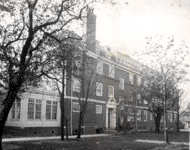Betsy Barbour Dormitory

- Construction begun in August 1911, completed October 1920
- Architects: Albert Kahn of Detroit, Michigan
- Contractor: W.E. Wood Co. of Detroit
- Total Cost: $167,568.95
- Furnishings: $42,171.16
- Building funds donated by Hon. Levi L. Barbour in memory of his mother Betsey Barbour.
[View more images of Betsy Barbour House]
In 1917 the University announced a gift from the Honorable Levi L. Barbour ('63, '65 law) for many years a Regent of the University, of $100,000 and several parcels of land, to be used for the construction of a dormitory for women in memory of his mother:
Whereas The Hon. Levi L. Barbour, of Detroit, Michigan, a former member of this Board, has again evidenced his great interest in the University of Michigan and his abundant generosity in providing for its welfare and has proposed to give to it the sum of one hundred thousand dollars .... for the establishment and maintenance of a women's residential hall,
Now, Therefore, Be it Resolved, That the Board of Regents of the University of Michigan does hereby accept, with gratitude: the gift of the Hon. Levi L. Barbour, of Detroit, Michigan, of the sum of $100,000 consisting of money obligations and securities that the Treasurer of the University be authorized and directed to take over said securities when they have been duly assigned and transferred to the Board, and to attend to the collection of all moneys which are due, or may become due thereon, and that the proceeds be used for the purpose of constructing, furnishing, and equipping, upon property owned or to be acquired by the Board of Regents of the University, a residential hall for women, which shall be known as "Betsy Barbour House"; and that the administration of the affairs of said residence be delegated by this Board to a board of governors consisting of five women, two of whom shall reside in Ann Arbor, and two of whom shall reside in the City of Detroit or elsewhere outside Ann Arbor; two of whom shall be appointed by this Board for two years and two for four years, and every two years thereafter two members shall be appointed for four years from names to be submitted by members of said board of governors. The fifth member of said board shall be the Dean of Women of the University, ex officio. ( R.P., 1914-17, P. 783-84.)
Later, lots in Detroit were given to the University by Mr. Barbour and sold as agreed for $5,000 to provide additional funds for the completion of the dormitory.
Regent Barbour had traveled extensively before World War I, and in his travels he came in contact with two brilliant Chinese girls whom he brought back with him and sent to the University to be educated. One of these girls developed tuberculosis and died. Mr. Barbour investigated living conditions on campus and found them decidedly inferior. It became his dream to build an ideal dormitory, and he immediately made plans for the construction of such a building.
Albert Kahn, of Detroit, was selected as the architect. Because of the war, however, it was decided, in February, 1918, to postpone the construction of the dormitory. It was not until August, 1919, that a contract for $80,700 was signed with the W. E. Wood Company, of Detroit, providing only for the enclosed structure and not for its completion.
The building was finally completed and opened for the use of University women in October 1920. By that time Mr. Barbour was too ill to make the trip from Detroit, and he never saw the dormitory actually occupied, but it was dedicated to his mother, and he took great pains to see that her favorite antique rocker was placed in the small reception room on the first floor.
The Regents' Proceedings for March, 1921, announced:
The Secretary filed a report detailing the cost of the erection and furnishing of the Betsy Barbour House in accordance with the agreement with former Regent Levi L. Barbour .... [showing] the cost of the building as $167,568.95 and the furnishings as $42,171.16, total $215,340.11. Against these expenditures were total proceeds from Mr. Barbour's gifts applicable to the purpose, of $178,635.40 and the sum of $200,000 appropriated by the Regents on February 20, 1920. (R.P., 1920-23, P. 163.)
Betsy Barbour House is situated next to Helen Newberry Residence on State Street, across from Angell Hall. It is constructed of light red brick with white trim and is distinguished by a glass-enclosed porch along the eastern end. The main floor is devoted chiefly to large living rooms with smaller connecting lounges, a dining hall, and offices, in addition to several student rooms. The upper floors are devoted entirely to student rooms.
The reception rooms on the first floor contain many pieces of furniture from Regent Barbour's old home in Detroit. He also bequeathed a valuable library and many paintings and objects of art collected by him on his many travels, in addition to pictures and certain gifts for the girls' rooms.
Interior decoration and equipment of kitchens were planned by Mrs. J. R. Effinger and Mrs. Julius Schlotterbeck in co-operation with Dean Jordan and Miss Eleanor Sheldon, the first director of Betsy Barbour House.
Betsy Barbour House provided living accommodations for eighty-one girls in sixty-nine single and six double rooms. The need of additional housing for women made it necessary to increase the capacity of the house by 1954 So that 116 girls were accommodated in the building. In 19S3 the large single rooms were made into double rooms. The remodeling resulted in thirty-two single and forty-two double rooms which were refurnished in 1953-54
Source: The University of Michigan: An Encyclopedic Survey; Walter A. Donnelly, Wilfred B. Shaw, and Ruth W. Gjelsness, editors; Ann Arbor : University of Michigan Press, 1958.